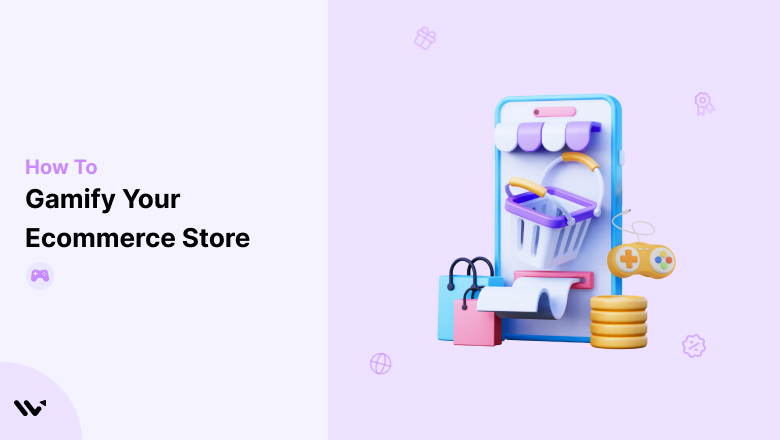If you wish your online store could be as addictive as a game, you are in the right place.
In this post, you will learn how eCommerce gamification, a market set to hit $30.7 billion by 2025, can do wonders for your business.
We will discuss the what, why, and how you can get started with ecommerce gamification refers.
Let’s get right to it.
Start Free Trial
Highlight real-time activities like reviews, sales & sign-ups.
eCommerce Gamification Explained In Simple Terms
eCommerce gamification is a inbound marketing strategy that uses game-like elements to engage your online store with visitors.
It’s about making the process of browsing and buying more interactive and fun using points, badges, leaderboards, and challenges.
Using gamification techniques means a more enjoyable shopping experience to attract new customers and keep existing ones coming back.
Gamification techniques makes shopping feel less like a chore and more like a rewarding and exciting adventure.
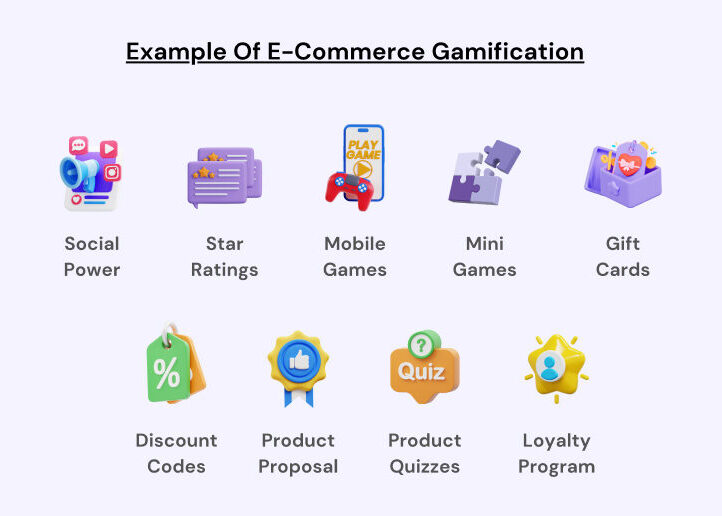
When & Who Can Benefit From Gamification
If you fall into any of these categories, it’s high time you consider gamification for your eCommerce store
1. Fashion & Apparel Stores
Fashion and apparel stores can use virtual try-ons and style quizzes to help customers find their perfect look, making shopping feel more personalized.
You can reward customers with points and badges for their purchases, reviews, and referrals, the little nudge to make them come back and shop more.
2. Beauty & Skincare Brands
Offer virtual makeovers and skin quizzes to help them find the perfect products for their needs.
You can reward customer loyalty with exclusive discounts and early access to new products to create a loyal customer base eager to see what you’ll offer next.
3. Food & Beverage Delivery Services
You can create fun challenges: trying new dishes or completing a certain number of orders to unlock special discounts, surprise rewards, or free items.
4. Tech & eCommerce Learning Platforms
Offer quizzes to help customers find the tech or courses (it can get overwhelming when you have eCommerce courses as many as these) they need.
Give them exclusive early access to new releases or or masterclass programs for completing reviews or sharing on social media.
5. Fitness & Wellness Product Sellers
Create challenges that encourage customers to achieve their fitness goals like a ‘30-day fitness challenge’ and reward them with discounts or free products for their progress.
You can also offer personalized recommendations and tracking tools to make them more likely to come back and continue their wellness journey with your products.
But your potential customer’s journey involves multiple touchpoints, where should you gamify?
Consider these 5 areas;
I. To Welcome New Customers
Gamify the welcome experience to build a memorable first impression and set the tone for an engaging relationship with your brand. You can offer them a fun and interactive onboarding process like a welcome quiz to help them find products they like.
You can also offer new customers initial rewards for signing up. It could be points, discounts, or a welcome badge.
II. During Checkout To Reduce Cart Abandonment
At this critical stage of customer experience, you can introduce interactive elements like progress bars that show how close customers are to completing their purchases. This visual cue will motivate them to finish the checkout process.
You can unlock instant incentives like a small discount or bonus points–the extra push they need to finalize their order. This makes the checkout process more satisfying.
III. Post-Purchase To Encourage Reviews & Feedback
After a customer purchases, invite them to participate in a quick, interactive survey or review with points, discounts on future purchases, or entry into a prize draw in exchange.
You can also create a tiered system where customers earn badges or levels based on the number of reviews they leave.
For example, if your eCommerce store sells home improvement products, you can partner with a local window cleaning service like this to offer a free window cleaning session as a reward for completing reviews.
Don’t forget to check: The #1 Product Reviews App For Your Online Store
IV. For Loyalty Programs To Reward Repeat Purchases
Create a points-based system where customers earn rewards for every purchase. Customers can accumulate points to redeem discounts, free products, or exclusive perks to add an element of excitement to their shopping experience.
You can also level or tiers in your loyalty program. Each tier can offer increasing benefits like early access to new products or special sales.
V. During Seasonal Sales to Drive More Engagement
Add countdown timers for limited-time offers to create a sense of urgency and encourage customers to purchase quickly.
You can also introduce fun challenges or quests where customers earn rewards or discounts for buying a certain number of items or sharing your sale on social media.
You can also host seasonal contests, offering exclusive prizes to create a lively and interactive online shopping experience.
5 Benefits Of Gamification In eCommerce
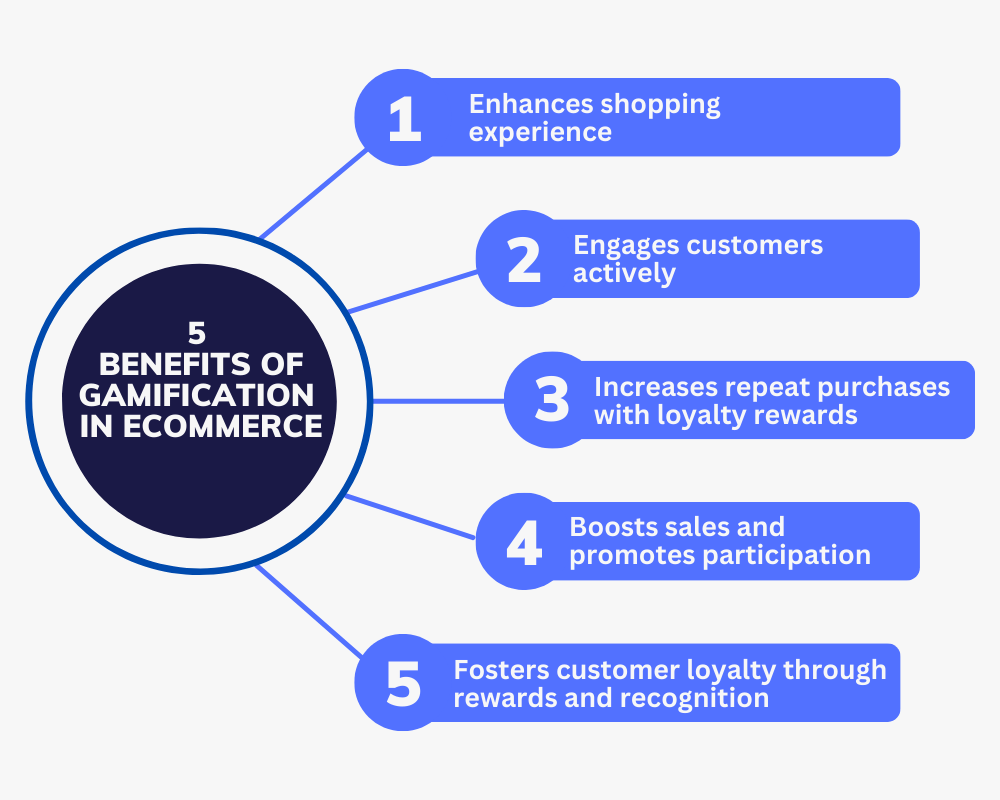
- Creates a more enjoyable shopping experience
- Keeps customers interested and active on your site
- Encourages customers to return and make more purchases by rewarding their loyalty
- Drives higher sales by motivating customers to complete purchases and participate in promotions
- Builds stronger relationships with customers when you offer rewards and recognition for their interaction.
Start Free Trial
Highlight real-time activities like reviews, sales & sign-ups.
3 Real-Life Examples Of eCommerce Gamification
Now let’s see gamification in action. Pay close attention to why each example leveraged gamification and how they did it.
Then, consider the results and see if they match your goals.
1. Nike
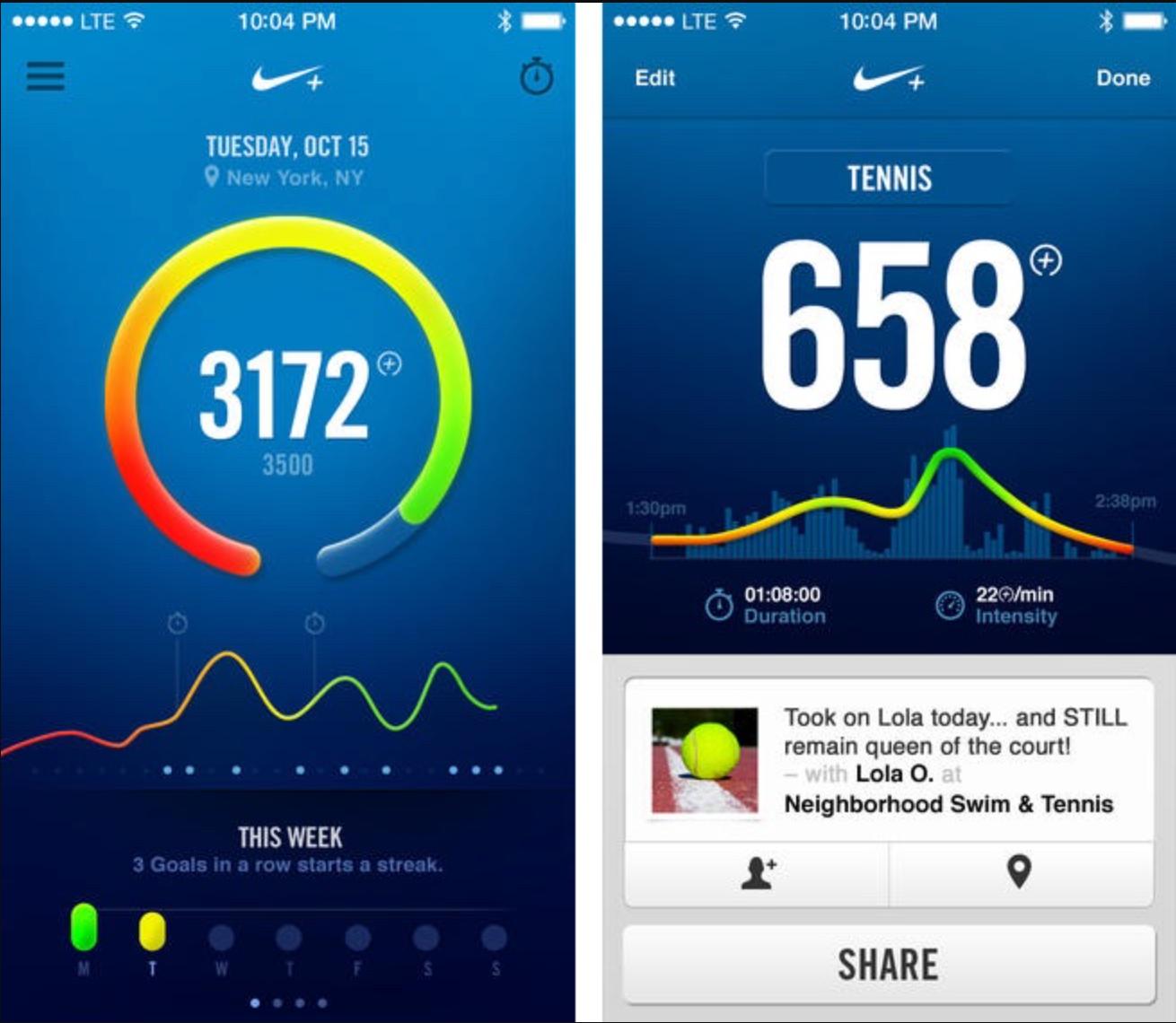
Nike implemented the NikeFuel points system on their Nike+ app, where users earned points for their physical activities.
This motivated customers to stay active and purchase more products to improve their performance.
As a result, Nike saw a 55% increase in app usage and a 30% rise in product sales linked to the app.
2. Sephora
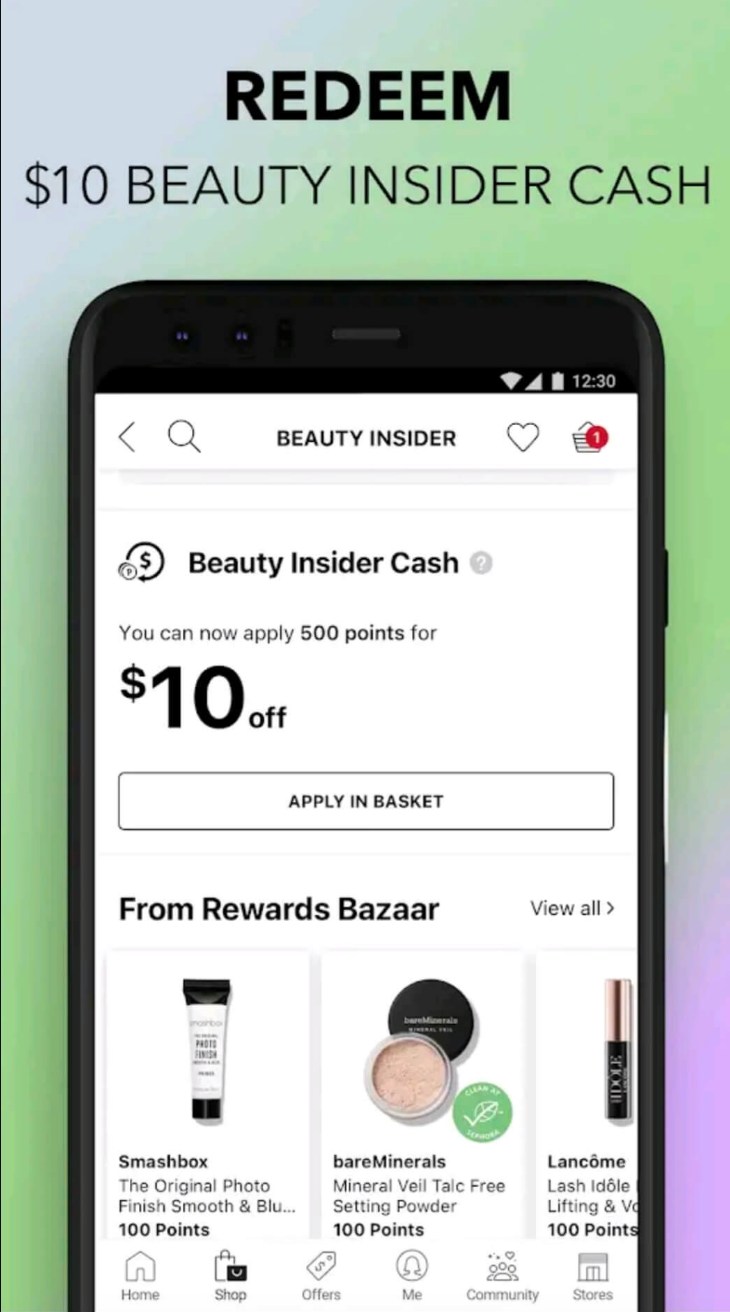
This beauty retailer used several gamification strategies to scale their loyalty program.
They introduced the Beauty Insider program, where customers earned points for purchases, reviews, and social media interactions.
These points could be redeemed for exclusive products and experiences. Using this strategy, they increased customer loyalty by 35% and drove a 20% increase in repeat purchases.
3. Starbucks
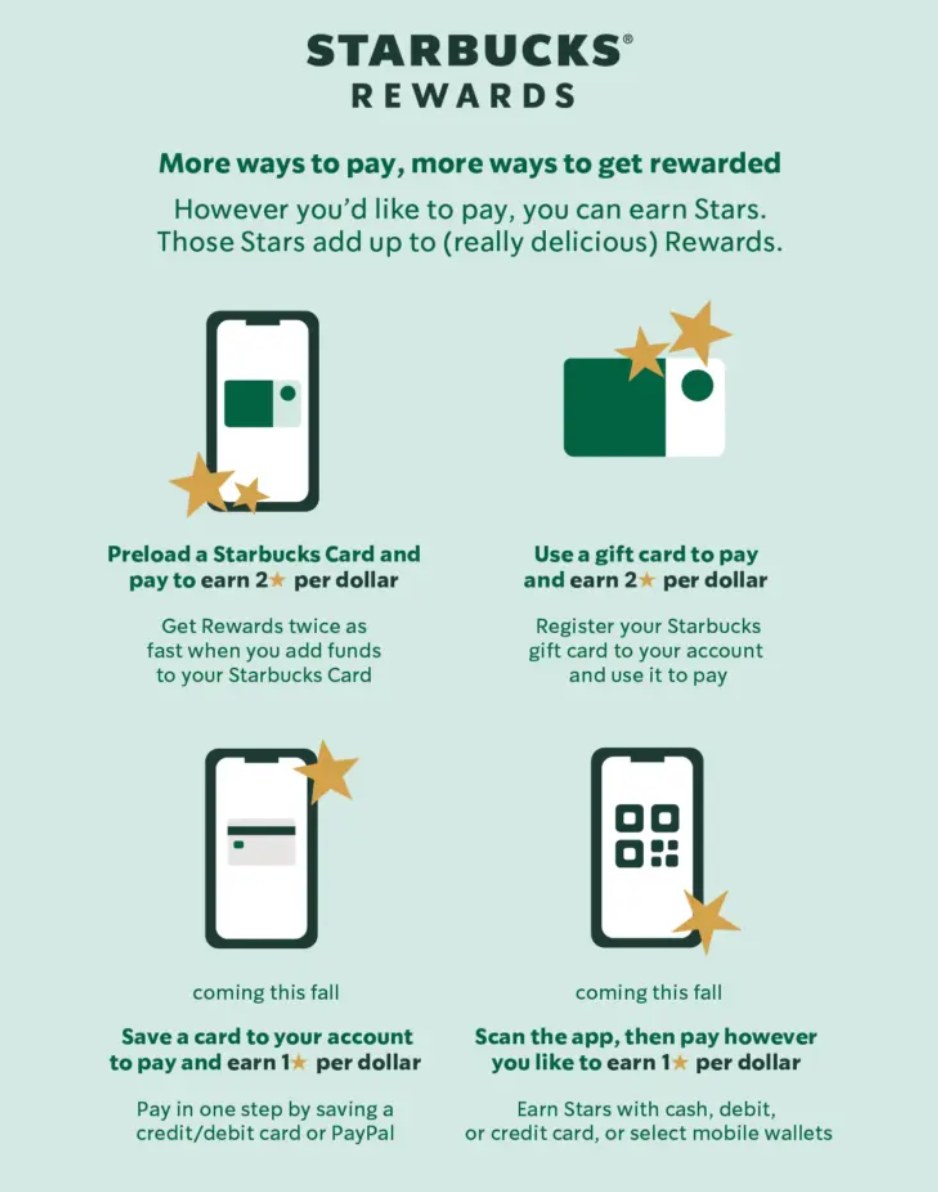
Starbucks used gamification to drive customer loyalty and repeat purchases.
They launched the Starbucks Rewards program, where customers earned stars for every purchase made using their app.
With a set number of stars, customers can unlock free drinks, food, and personalized offers.
This increased app transactions by 25% and improved customer engagement and retention rates by 40%.
How To Start Gamifying Your eCommerce In 5 Steps
No, it’s not as complicated as it looks. As you go through each step, consider how you can align the steps with your business goals.
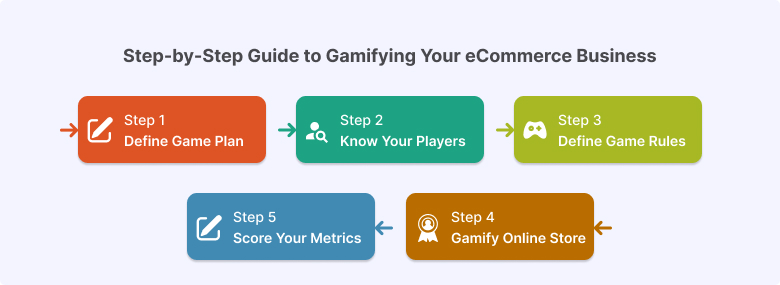
Step 1: Define Your Game Plan
This involves setting clear objectives about what you want gamification to do for your business. Here’s how you can do it:
1.1 Identify Your Goals
What do you want to accomplish with gamification? Do you want to:
- Improve sales?
- Educate your customers?
- Encouraging repeat purchases?
- Or gathering customer feedback?
- Increasing customer engagement?
Here’s an excellent example if you want to educate your audience: AlisQI is a software solution users need to feel that it’s easy to use so they will be interested to pay for.
If your goal is to use education to drive more sales, you will know to implement a simulation game where users manage a virtual production line to solve quality issues.
If the user succeeds in the simulation they can earn exclusive training resources or consultation credits.
1.2 Know Your Metrics
Decide how you will measure success. This could be through metrics like increased time spent on your site, higher conversion rates, more frequent purchases, or better customer feedback scores.
Write these down so you can track your progress.
1.3 Set Achievable Milestones
Break down your goals into smaller, manageable steps.
For example, if your goal is to increase customer engagement, you could set a milestone of 500 customers to participate in your first gamified challenge within the first month.
1.4 Understand Your Resources
Assess what you have at your disposal: budget, your team, and any tools or software you might need.
For example, if you plan to implement a points system, make sure you have the right software to track and manage points.
1.5 Create A Timeline
Set a realistic timeline: when you want to start, when you want to launch each gamified element, and when you’ll evaluate your progress.
If you don’t have any idea how long each stage should be, work with an expert developer to help you.
1.6 Get Team Buy-In
Make sure your team understands and supports the gamification plan.
Share your goals and timelines with them, and assign specific roles and responsibilities.
For example, one team member can be in charge of designing the challenges, while another person handles the technical integration.
You don’t have to spend a fortune if you don’t have these team members yet, you can hire an intern because they are cost-effective solutions.
Step 2: Get to Know Your Players
Knowing what motivates and engages your customers so you can design a gamification user engagement strategy that resonates with them.
Here’s how to get started:
2.1. Analyze Customer Data
Look at your existing customer data to identify patterns and how customer preferences are.
Check your purchase history, browsing behavior, and feedback.
If you notice that a significant number of customers frequently purchase fitness gear, you can create fitness milestones challenges like a “10,000 Steps Challenge” or offer rewards such as exclusive discounts on the latest workout apparel.
2.2 Segment Your Audience
Segment your customers based on whether they are new customers, repeat buyers, or high-spending customers and create tailored games.
For example, you could offer new customers simple challenges like “Complete Your First Purchase to Earn 500 Points,” while loyal customers with more complex tasks like “Share a Photo of Your Workout Routine for a Chance to Win Exclusive Gear.”
2.3 Create Customer Personas
Develop each persona based on demographic information, shopping habits, motivations, and pain points.
For example, a persona might be “Jane, a 30-year-old fitness enthusiast who values health-related rewards and enjoys tracking her progress.”
2.4 Identify Motivators
Know whether your customers are motivated by discounts, exclusive access, social recognition, or personal achievement so you can design gamification elements that will appeal to them.
For example, if your customers value social recognition, use leaderboards and social sharing features.
2.5 Monitor Social Media & Reviews
Pay attention to what customers are saying about your brand on social media and in reviews.
It will tell you about their likes, dislikes, and what they find engaging.
Refine your gamification strategy based collect customer data and on what you learn there.
Step 3: Select Your Game Mechanics
Here’s how to select the best game elements for your eCommerce store:
3.1 Match Mechanics To Goals
Align your game mechanics with the objectives you set in Step 1. If your goal is to increase customer engagement, implement a points system where customers earn points for every purchase, review, or social media share.
They can then use the points to redeem discounts or free products.
3.2 Consider Your Audience’s Preferences
Use what you learn in Step 2 to choose game mechanics that resonate with your customers.
Earlier we mentioned that if your audience loves social recognition, use leaderboards.
The leaderboard can show top customers based on points earned and let them share their achievements on social media for more rewards, which can also double as you social media marketing strategy.
3.3 Incorporate Variety
This could involve challenges, quizzes, badges, and progress bars.
For example, you might introduce a weekly quiz about your products, where customers can earn badges for participating and additional points for correct answers.
3.4 Make It Achievable
Start with simple tasks to build your customers confidence and gradually introduce more complex challenges.
For example, begin with a basic challenge like “Make Your First Purchase to Earn 100 Points,” and then offer more advanced challenges like “Complete 5 Purchases in a Month to Unlock a Special Discount.”
Let’s dive deep: 7 Genius Limited-Time Offers Examples to Boost Sales
3.5 Reward Milestones
Recognize and reward customers for reaching a certain number of points, completing a set number of purchases, or participating in challenges.
3.6 Ensure Integration
Use tools that support the features you need and ensure a smooth user experience.
For example, if you’re implementing a points system, use Smile.io or Yotpo for Shopify or Gratisfaction for WooCommerce to automatically track and update points for every customer action.
Step 4: Weave Gamification Into Your Storefront
Here’s what you need to do:
4.1 Choose The Right Platform
Pick from Shopify, WooCommerce, and Magento. These 3 offer the most plugins and gamification integrations.
4.2 Design A User-Friendly Interface
Make sure the gamification elements are easy to access and understand.
For example, create a dedicated section where customers can view their progress, earned rewards, and available challenges.
4.3 Integrate Seamlessly
Avoid making them look out of place or like an afterthought.
If you’re adding a points system, integrate it into the product pages, checkout process, and user dashboard.
4.4 Highlight Gamification On Key Pages
Promote your gamification features on high-traffic pages–homepage, product pages, and checkout pages.
Use banners, pop-ups, or notifications to inform customers about the gamified elements.
4.5 Give Clear Instructions
Make sure customers know how to participate in your gamification programs.
Offer clear, step-by-step instructions on how to earn points, complete challenges, and redeem rewards.
You can create a FAQ section or tutorial videos to help them understand the process.
4.6 Test for Usability
Before fully launching your gamified features, test how usable it is to make sure they work as they should and are easy to use.
Work with a small group of testers and make adjustments based on their feedback.
For example, if users find the points redemption process confusing, simplify the steps or provide more detailed guidance.
Step 5: Score Your Success Metrics
Here’s how you can score your success metrics:
5.1 Define Key Metrics
Here’s an idea of what you should track for each goal:
Increase Customer Engagement
- Time Spent on Site
- Number of Completed Challenges
- Social Shares
Boost Repeat Purchase Rate
- Repeat Purchase Rate
- Customer Retention Rate
- Frequency of Purchases
Increase New Customer Acquisition
- New Customer Sign-Ups
- Referral Rates
- Conversion Rate from Promotions
Learn more? Here you go: 15 High Impact Customer Acquisition Strategies
5.2 Use Analytics Tools
Use Google Analytics, Shopify Analytics, and WooCommerce Reports to track customer behavior and how your gamification elements perform.
Set up custom reports to monitor specific KPIs to make your customer success efforts measurable .
5.2 Monitor Customer Participation
Keep an eye on how many customers are participating in your gamified activities.
Track the number of sign-ups for challenges, points earned, and rewards redeemed.
5.3 Compare Performance Over Time
Analyze how your gamification strategy performs over different periods.
Compare data month over month or quarter over quarter to identify trends and patterns.
5.4 Adjust & Improve
If certain challenges or rewards are not resonating with customers, tweak them based on the data you collected.
Review and refine your gamification elements every quarter or 2x per year to keep them fresh and engaging.
5 eCommerce Gamification Challenges & How To Fix Them
While gamification offers great benefits, it also has potential pitfalls.
Pay attention to these challenges and have strategies in place to resolve them quickly.
I. Complex Setup
Setting up gamification features can be tricky and time-consuming. To avoid this, use easy-to-install tools and plugins designed for gamification.
II. Customer Overload
Giving customers too many challenges or rewards will lose their interest. To fix this, keep your gamification simple and stick to 1 or 2 at a time.
III. Cost vs. Reward
Offering rewards without losing money is almost impossible. To avoid this, plan your rewards carefully and calculate if the ROI is worth it.
IV. Fairness & Clarity
Customers might get upset if they think the system is unfair or confusing. To fix this, make sure the rules and rewards are clear and easy to understand.
V. Keeping Interest Alive
It will be challenging to keep customers interested in the long run. To avoid this, update challenges and rewards every quarter or every 6 months and listen to customer feedback to keep things exciting.
Conclusion
As you implement these strategies, always ask yourself: “Is this marketing strategy really getting the ROI it should?
What else can I do to keep my customers engaged and excited to come back to my store?”
This mindset will help you stay proactive and responsive to your customers’ evolving needs.
Always think what will make your business valuable and credible in your audience’s eyes.
At WiserNotify we make this easy for your with trust features you can add in your own eCommerce websites or store.
Check out our solutions today and turn more casual browsers to trusting repeat buyers.
Author Bio:

Burkhard Berger is the founder of Novum™. He helps innovative B2B companies implement modern SEO strategies to scale their organic traffic to 1,000,000+ visitors per month. Curious about what your true traffic potential is?
